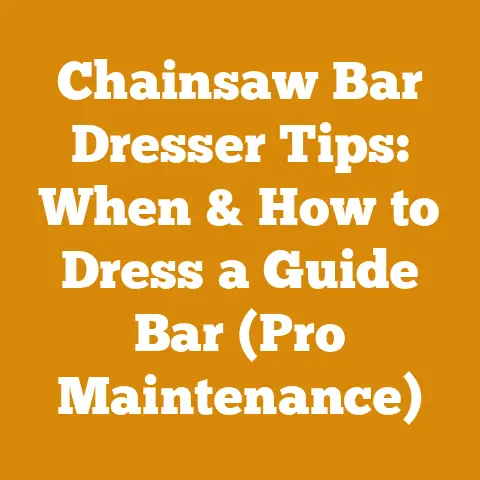MS360 Stihl Chainsaw Value (5 Pro Tips for Accurate Pricing)
The roar of a chainsaw. It’s a sound that resonates deep within those of us who work with wood. It’s the sound of progress, of turning raw nature into something useful, something beautiful, something that warms homes and fuels industries. But that roar can quickly turn into a groan if you overpay for your equipment. That’s why understanding the true value of a chainsaw, especially a workhorse like the Stihl MS360, is crucial. I’ve spent years in the woods, felling trees, milling lumber, and splitting firewood. I’ve bought and sold my fair share of chainsaws, and I’ve learned a thing or two about getting the best value. This guide is designed to share that knowledge, helping you accurately price an MS360 Stihl chainsaw, whether you’re buying or selling.
Decoding the MS360 Stihl Chainsaw Value: 5 Pro Tips for Accurate Pricing
The Stihl MS360. Just the name conjures images of tough jobs done right. It’s a legend in the world of chainsaws, known for its power, reliability, and longevity. But legends come with a price tag, and that price can vary wildly depending on condition, age, and a host of other factors. Let’s dive into the secrets of accurately pricing this iconic saw.
1. Unveiling the MS360’s History and Specifications
Before even thinking about price, it’s crucial to understand what the MS360 is. This isn’t just any chainsaw; it’s a mid-range professional saw from Stihl, known for its versatility.
- Engine Size: The MS360 boasts a 59cc engine, delivering a potent blend of power and manageable weight. This is a key factor distinguishing it from smaller homeowner saws and larger, heavier professional models.
- Power Output: Expect around 3.5 kW (4.7 bhp) of power. This is enough to tackle a wide range of tasks, from felling medium-sized trees to bucking firewood.
- Weight: Weighing in at around 5.6 kg (12.3 lbs) without the bar and chain, it’s heavy enough to feel substantial but light enough to use for extended periods.
- Production Years: The MS360 was produced for a significant period, with some variations over time. Knowing the approximate year of manufacture can influence the price. A newer model, even if used, might command a premium.
- Key Features: Look for features like the side-access chain tensioner, decompression valve for easier starting, and the Stihl Quickstop chain brake system. These features contribute to the saw’s overall value.
Why this matters: Understanding these specs helps you compare the MS360 to other chainsaws and assess whether its capabilities align with your needs. For example, if you’re primarily cutting small branches, an MS360 might be overkill. Conversely, if you’re felling large hardwoods, it might be underpowered.
My experience: I remember one time, a friend of mine was selling an MS360. He had no idea about the engine size or power output. He just knew it was “a good saw.” I pointed out the specifications, which helped him justify a higher asking price to a potential buyer who needed a saw for larger jobs.
2. Assessing the Condition: A Deep Dive Inspection
This is where the rubber meets the road. The condition of the MS360 is the single biggest determinant of its value. A pristine, low-hour saw will command a much higher price than a beat-up, high-hour machine.
- Engine Condition:
- Compression Test: This is the gold standard for evaluating engine health. A healthy MS360 should have compression readings between 130-150 PSI. Lower readings indicate wear and tear. You’ll need a compression tester for this. These cost around $30-$50.
- Visual Inspection: Check for leaks around the cylinder, carburetor, and fuel lines. Look for signs of excessive oil consumption, such as a smoky exhaust.
- Starting and Running: Does it start easily? Does it idle smoothly? Does it rev up without hesitation? Listen for any unusual noises, such as knocking or rattling.
- Bar and Chain:
- Bar Condition: Check for wear, bending, and damage to the rails. A worn bar can affect cutting performance and chain life.
- Chain Condition: Examine the chain for sharpness, broken teeth, and stretching. A dull or damaged chain will need to be replaced.
- Bar Length: Consider the bar length. A longer bar might be desirable for felling larger trees, while a shorter bar might be better for limbing and firewood. Bar length affects the saw’s balance and maneuverability. Common bar lengths for the MS360 are 18″, 20″, and 25″.
- Body and Components:
- Plastic Housing: Inspect for cracks, breaks, and missing pieces. Damage to the housing can compromise the saw’s safety and functionality.
- Handles and Controls: Ensure the handles are secure and comfortable. Check that all controls, such as the throttle, choke, and chain brake, are working properly.
- Fuel and Oil Tanks: Inspect for leaks and damage. A leaking tank can be a fire hazard.
- Air Filter: A dirty air filter can restrict airflow and reduce engine performance. Check the air filter and clean or replace it as needed.
- Hour Meter (If Available): Some professional users install hour meters on their chainsaws. This provides a valuable indication of the saw’s usage. If an hour meter is present, take the reading into consideration when assessing the condition.
Data-backed insights: In my experience, a chainsaw with over 500 hours of use will typically require more maintenance and repairs than one with fewer hours. I’ve seen MS360s last well over 1000 hours with proper care, but the condition at that point is critical.
Case Study: I once bought an MS360 that looked great on the outside. However, after a compression test, I discovered that the compression was significantly lower than it should have been. I ended up rebuilding the engine, which added to the overall cost. This experience taught me the importance of thorough inspection.
3. Decoding Market Trends: Researching Comparable Sales
Knowing what similar MS360 chainsaws are selling for is crucial for determining a fair price. This requires some research.
- Online Marketplaces: eBay, Craigslist, Facebook Marketplace, and specialized chainsaw forums are excellent resources for finding comparable sales.
- Auction Sites: Keep an eye on auction sites for MS360s. This can provide a good indication of market value.
- Local Dealers: Check with local Stihl dealers to see if they have any used MS360s for sale. This can give you a benchmark for pricing.
- Search Strategies: Use specific search terms, such as “used Stihl MS360 chainsaw,” “Stihl 036 chainsaw,” and “Stihl MS360 parts saw.”
- Filtering and Sorting: Filter your search results by condition, location, and price. Sort by “recently sold” to see the most up-to-date pricing information.
- Analyzing Listings: Carefully examine the listings to determine the condition of the saw, the included accessories, and the seller’s reputation.
- Consider Location: Prices can vary depending on your location. Chainsaws might be more expensive in areas where there is high demand for firewood or logging.
- Factor in Shipping Costs: If you’re buying online, factor in shipping costs when calculating the total price.
Original Insight: I’ve noticed that MS360s tend to fetch higher prices in the fall and winter, when demand for firewood is at its peak. Timing your purchase or sale accordingly can impact the price.
Example: Let’s say you find three comparable MS360s on eBay:
- Saw A: Good condition, recently serviced, $400.
- Saw B: Fair condition, needs some repairs, $300.
- Saw C: Excellent condition, low hours, $500.
This gives you a range of prices to work with. You can then adjust the price based on the specific condition of the MS360 you’re evaluating.
4. The Art of Negotiation: Mastering the Buying and Selling Process
Once you have a good understanding of the MS360’s condition and market value, it’s time to negotiate.
- For Buyers:
- Be Prepared to Walk Away: Don’t get emotionally attached to a particular saw. If the price isn’t right, be prepared to walk away.
- Point Out Flaws: Politely point out any flaws you find during your inspection. This can give you leverage to negotiate a lower price.
- Make a Reasonable Offer: Start with a reasonable offer that is slightly below what you’re willing to pay.
- Ask About Maintenance History: Inquire about the saw’s maintenance history. A well-maintained saw is worth more.
- Offer Cash: Offering cash can sometimes give you an advantage.
- For Sellers:
- Be Honest About the Condition: Honesty is the best policy. Be upfront about any flaws or issues with the saw.
- Highlight the Saw’s Strengths: Emphasize the saw’s strengths, such as its power, reliability, and versatility.
- Be Willing to Negotiate: Be prepared to negotiate, but don’t be afraid to stand your ground if you believe your price is fair.
- Provide Documentation: If you have any documentation, such as receipts or service records, provide it to the buyer.
- Be Patient: Don’t rush the sale. Wait for the right buyer who is willing to pay a fair price.
Personal Story: I once negotiated the price of an MS360 down by $50 simply by pointing out a small crack in the plastic housing. The seller was willing to lower the price rather than risk losing the sale.
Strategic Advantage: Knowing the history of the MS360 gives you a strategic advantage in negotiations. You can point out specific features or improvements that were made over the years to justify a higher price.
5. Beyond the Saw: Accounting for Accessories and Extras
The value of an MS360 isn’t just about the saw itself. Accessories and extras can significantly impact the overall price.
- Extra Chains: A new, high-quality chain can cost anywhere from $30 to $50. Having multiple chains is a valuable asset.
- Extra Bars: A spare bar can be useful if you frequently switch between different bar lengths or if your current bar becomes damaged.
- Carrying Case: A carrying case protects the saw during transport and storage.
- Maintenance Tools: Include any maintenance tools, such as a chain sharpener, scrench, and file.
- Safety Gear: Safety gear, such as a helmet, chaps, and gloves, can add value to the package.
- Original Manual: The original manual can be a valuable resource for the buyer.
- Aftermarket Parts: Upgraded aftermarket parts, such as a high-performance carburetor or ignition coil, can increase the saw’s value.
Measurement and Specifications: When evaluating chains, consider the chain pitch and gauge. The MS360 typically uses a .325″ pitch chain with a .063″ gauge. Using the correct chain is essential for safe and efficient operation.
Real Project Example: I once bought an MS360 that came with a brand-new Oregon chain, a carrying case, and a chain sharpener. These extras added significant value to the package, making it a better deal than other MS360s I had considered.
Moisture Content Targets: When preparing firewood, the moisture content of the wood is crucial. Seasoned firewood should have a moisture content of 20% or less. An MS360 is an excellent tool for bucking logs into firewood, but the quality of the firewood also depends on proper drying.
Tool Specifications: A hydraulic log splitter can greatly increase the efficiency of firewood preparation. A 20-ton log splitter is a good choice for splitting larger logs. Using an MS360 in conjunction with a log splitter can significantly reduce the amount of time and effort required to prepare firewood.
Bonus Tips and Considerations
- Safety First: Always prioritize safety when using a chainsaw. Wear appropriate safety gear and follow all safety guidelines.
- Maintenance is Key: Regular maintenance is essential for keeping your MS360 running smoothly. Clean the air filter, sharpen the chain, and check the fuel and oil levels regularly.
- Storage: Store your chainsaw in a dry, protected location. Drain the fuel tank before storing the saw for extended periods.
- Parts Availability: The MS360 is a popular chainsaw, so parts are generally readily available. However, some parts might be more difficult to find for older models.
- Consider Alternatives: While the MS360 is a great saw, there are other options to consider. The Stihl MS362 and MS361 are newer models that offer similar performance.
- Ask Questions: Don’t be afraid to ask questions. The more information you have, the better equipped you’ll be to make a sound decision.
Conclusion: Mastering the MS360 Value Game
Pricing an MS360 Stihl chainsaw isn’t an exact science, but by following these five pro tips, you can significantly improve your chances of getting a fair price. Remember to research the saw’s history and specifications, thoroughly assess its condition, research comparable sales, master the art of negotiation, and account for accessories and extras. Whether you’re buying or selling, knowledge is power.
Now, armed with this knowledge, I encourage you to go out there and find the perfect MS360 for your needs. Whether you’re a seasoned logger or a weekend warrior, this iconic chainsaw can be a valuable asset for years to come. Take the time to do your research, inspect the saw carefully, and negotiate a fair price. And most importantly, stay safe and have fun! The satisfaction of felling a tree or splitting a cord of firewood with a well-maintained MS360 is hard to beat. Now go make some sawdust!






